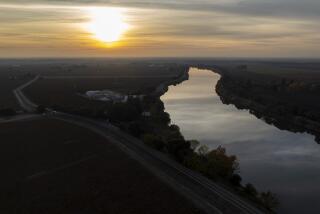Doing Business : No Light at Chunnel’s End : * The underwater drilling is done, but on land, the giant Channel Tunnel is headed for trouble. Everything’s going wrong.
- Share via
LONDON — Just a few months ago, it seemed that all systems were go for the English Channel Tunnel--the first land link between Britain and the Continent since the melting of the Ice Age 10,000 years ago.
The underwater tunneling was completed; work continued apace on the $15-billion project that will ferry passengers and freight by rail, and it appeared that June, 1993, start-up deadline would be met.
Suddenly, everything now seems to be going wrong: The British government overruled British Rail on the location of the high-speed rail route from the channel to central London; project operator Eurotunnel is arguing with several contractors over costs and future financing; long delays are forecast in supplying fast-rolling stock, and financiers suggest that even when trains begin running, the project faces rising costs and falling revenues.
Even the European Community has gotten into the act with its executive, the European Commission in Brussels, questioning whether the British Rail routes and new terminals will meet environmental standards.
The troubles surfaced first in early October when--after the tunneling itself was finished, and installation begun of track, pipe work, cabling, signaling, cooling, and other equipment--the British government, after four years of dithering, unexpectedly vetoed the fast connector line picked by British Rail.
The new route approaches London from the east rather than from the south and is expected to be much more costly--an extra $1 billion or more--because of the longer distance and the construction of new London terminals.
It will be even more expensive to British Rail because the corporation was hoping to use the new right-of-way on which its proposal was based to serve increased commuter centers south of London as well as the “Chunnel” traffic.
Though some British industrialists plumped for the eastern approach because of the convenience of shifting freight to northern England and Scotland, the selection in the end was taken for political reasons.
Several Conservative members of Parliament have marginal districts in the Kent area, and conservationists mounted a major campaign to keep the new, fast rail route out of their back gardens.
Reaction by Eurotunnel and British Rail was one of cold fury: Eurotunnel Chairman Alastair Morton accused Transport Secretary Malcolm Rifkind of adding years to building the rail link and of making Britain a laughingstock with its French partners.
“It is a disaster,” he said.
British Rail Chairman Bob Reid declared: “A golden opportunity has been missed here. This decision has been taken for political, not transport reasons.”
The announcement was bad news for British Rail, which invested millions in buying property along its proposed right-of-way--as well as enlarging Waterloo Station to receive the inter-continental trains. Waterloo was rejected as the London terminus in favor of Kings Cross station.
The question of the funding of the new route remains unanswered: the British government is prohibited from pumping public money into the tunnel venture, but Transport Secretary Rifkind indicated that some government cash might be available if the line could boost commuter services.
Eurotunnel was still reeling from that decision when it was announced that the delivery on most of the tunnel trains would be delayed until well after the scheduled June, 1993, opening.
There are three types of trains planned for the tunnel crossing: shuttle trains that will carry passenger cars, buses and trucks from roadway terminals between Cheriton, England, and Sangatte, France; through-freight trains, and high-speed, nonstop 760-passenger trains linking London with Paris and Brussels.
But only about half the scheduled shuttle trains, which accept passengers only in cars or buses, will be ready by mid-1993, so there will be a much-reduced capacity in the first several months after the tunnel’s opening.
And the 186-mile-per-hour, through-passenger trains--called TMST and designed to make the London-Paris trip in less than three hours--will not be fully serviceable until the new high-speed rail line is constructed, which now is estimated to be around the year 2000. Meanwhile, these trains will be able to go directly from London to Paris only at a reduced speed, and their introduction into service will be delayed by months, if not years.
Ordinary British and continental trains cannot run through the tunnel because they have incompatible signaling and train-control systems.
The result is that British Rail and its continental partners will have no through-passenger trains ready for the scheduled opening date. And without a special rail bed, British trains can travel no more than 100 m.p.h.
So on opening day, a rail passenger wishing to travel from London to Paris will have to take a standard train to a British Channel port. Then, because the tunnel shuttle will not accept individual on-foot passengers, he will have to take a sea ferry across the channel, and there board another train to the French capital--no different than what he has to do now.
Not surprisingly, Eurotunnel has criticized the British government for its laggardly pace in building the new rail line and the necessary road connections with the tunnel.
Eurotunnel’s Morton said the operators were “dismayed by the failure” to provide the road infrastructure, calling efforts “hesitant and late.”
“We find this very depressing,” said Morton, “especially when there is very little contradiction between promise and performance on the French side.”
The Channel Tunnel Act prohibited the British government from providing funds. So Eurotunnel, a private company, raised its capital by selling shares--three-quarters held by French buyers--and borrowing from 210 banks. But the French and British governments were supposed to provide road and rail infrastructure with their funds.
“In the United Kingdom,” said Morton, “this provision appears to be falling far short of what is required to fulfill that compact--in regretable contrast to France.”
Tunneling was begun on the current project in 1987 and, by 1989, the cost was estimated at around $8.5 billion--but that has doubled today.
Eurotunnel earlier this year predicted it would earn $630 million in its first year with 15 million passenger journeys, a figure it estimated would rise to 45 million by 2003.
But the project has been troubled by over-optimistic predictions on costs and profits.
Currently, Eurotunnel and its contractors--some of the biggest in the industry--are at loggerheads over who should meet the annual budget for the tunnel.
The contractors say that Eurotunnel is behind on payments to them, cutting into their firms’ profit margins--while Eurotunnel argues that the contractors have not properly substantiated their claims.
The impasse, say financial experts, is likely to further complicate and delay the massive project.
As a spokeswoman for Eurotunnel put it cryptically: “Negotiations are ongoing.”
History of Fits and Starts Government’s last-minute rejection of British Rail’s route for land link to Channel Tunnel is latest hitch in much-delayed project. Some dates: 1802: French mining engineer Albert Malthieu draws plan for tunnel link, traveled by horse-drawn carriages, to Britain under English Channel. Hostilities between Britain and Napoleon’s France scuttle plan. 1851: British engineer proposes dropping giant iron tube into sea to create tunnel. 1880s: Digging begins on both sides. Ends due to British fears that French might invade through tunnel. 1920’s: Another proposal circulates but is quashed by British government. 1974-75: Digging begins again. Halted due to spiraling costs and environmental concerns. 1986: France and Britain choose design for current “Chunnel” rail tunnel. December, 1987: Digging begins. Cost forecast at $10 billion. Eurotunnel PLC to finance and run project; Transmanche Link is contractor. October, 1990: French and British teams, tunneling toward each other, break through and link Britain with Continent. Cost forecast rises to $15 billion.
More to Read
Sign up for Essential California
The most important California stories and recommendations in your inbox every morning.
You may occasionally receive promotional content from the Los Angeles Times.










